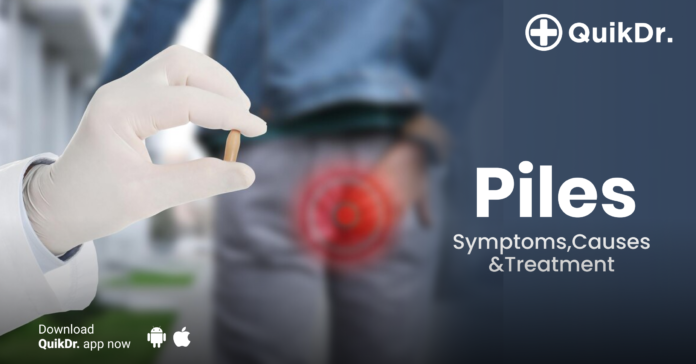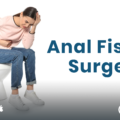Hemorrhoids occur when veins in the lower rectum and anus become swollen, potentially causing the development of tissue growths in and around the anal area. This condition may result in varying sizes and locations of these growths, leading to considerable discomfort.
Hemorrhoids, also known as piles, refer to inflamed veins situated inside or around the anus and lower rectum. This prevalent condition affects approximately 1 in 20 individuals in the United States. There are two categories of hemorrhoids based on their location: external hemorrhoids develop beneath the skin of the anus, while internal hemorrhoids form within the lining of the anus and lower rectum.
n numerous instances, hemorrhoids may develop without noticeable symptoms, going unnoticed by individuals. Alternatively, some cases present uncomfortable symptoms that necessitate treatment.
External hemorrhoid symptoms may encompass:
- Itching around the anus
- Pain around the anus, especially during sitting
- Tender lumps around the anus
Internal hemorrhoid symptoms may include:
- Bleeding during bowel movements
- Prolapse, where a hemorrhoid falls out of the anus
For hemorrhoids causing distressing symptoms, surgery is often the most effective treatment. This option is typically considered when symptoms persist despite other interventions like dietary changes.
The goal of surgery is to induce the shrinkage or elimination of the hemorrhoid, achieved by:
- Removing the hemorrhoid
- Reducing blood supply to the hemorrhoid
Surgery is beneficial for alleviating significant pain associated with symptoms, allowing for the prompt removal of the hemorrhoid. Nevertheless, the recovery period after surgery can extend over several weeks. An additional advantage of surgery is the capacity to address multiple hemorrhoids in a single procedure.
piles symptoms
Typically, the symptoms of hemorrhoids are not severe and tend to resolve spontaneously.
Someone with hemorrhoids might encounter the following symptoms:
- Painful lumps in and around the anus
- Itching and discomfort in the anal region
- Discomfort during and after bowel movements
- Bloody stools
While piles can progress into more serious conditions, such as:
- Excessive anal bleeding, potentially causing anemia
- Infection
- Fecal incontinence
- Anal fistula
- Strangulated hemorrhoid, where anal muscles restrict blood supply to the hemorrhoid
It’s important to note that many individuals with hemorrhoids may not experience any symptoms.
Causes
Hemorrhoids develop as a consequence of heightened pressure in the lower rectum.
Under pressure, the blood vessels surrounding the anus and rectum can stretch, leading to swelling or bulging and the formation of piles. This pressure can be attributed to factors such as:
- Persistent constipation
- Prolonged episodes of diarrhea
- Engaging in heavy lifting
- Straining during bowel movements
Risk Factors
Several factors can heighten an individual’s susceptibility to developing hemorrhoids, including:
- Pregnancy: Hemorrhoids affect up to 50% of people during pregnancy. This is attributed to increased pressure on the pelvis, elevated blood volume, and a higher prevalence of constipation.
- Age: Hemorrhoids are more prevalent among older adults, with approximately half of individuals over the age of 50 developing them.
- Weight: Research indicates that being overweight may raise the likelihood of developing hemorrhoids.
- Diet: A diet low in fiber may enhance the probability of an individual developing hemorrhoids.
Diagnosis
Typically, a doctor can diagnose hemorrhoids through a physical examination, specifically by inspecting the anus of the individual suspected to have piles.

During this examination, the doctor might inquire about the following:
- *Family history of hemorrhoids.
- *Presence of blood or mucus in stools.
- *Recent weight loss.
- *Changes in bowel movements.
- *Color of stools.
For internal hemorrhoids, a doctor may conduct a digital rectal examination (DRE) or employ a proctoscope—a hollow tube equipped with a light—to closely observe the anal canal. In some cases, the doctor may extract a small tissue sample from inside the rectum for analysis.
If indications or risk factors for colorectal cancer are evident, or if symptoms suggest another digestive system ailment, the physician might recommend a colonoscopy for a more comprehensive evaluation.
Treatments
In many instances, hemorrhoids tend to resolve spontaneously without requiring specific treatment. However, certain interventions can significantly alleviate the discomfort and itching often associated with hemorrhoids.

Lifestyle Modifications:
Initially, a doctor may recommend lifestyle changes to manage hemorrhoids. Since straining during bowel movements can contribute to hemorrhoid formation, addressing constipation through dietary adjustments is advised. This may involve increasing fiber intake with foods like fruits, vegetables, or bran-based breakfast cereals. Adequate water consumption and weight loss may also be suggested to reduce the frequency and severity of hemorrhoids. Additionally, doctors recommend exercise and avoiding straining during bowel movements as preventive measures.
Medications:
Various medications can help manage hemorrhoid symptoms:
- Pain relievers: Over-the-counter options like aspirin and ibuprofen can alleviate discomfort.
- Stool softeners: These can ease the passage of stools, reducing pain associated with hemorrhoids.
- Corticosteroids: Creams or ointments containing corticosteroids can reduce inflammation, pain, and itching.
Surgical Options:
In cases of severe prolapsed or bleeding internal hemorrhoids, surgery may be necessary. Surgical procedures include:
- Banding: Placing an elastic band around the base of the hemorrhoid to cut off its blood supply, causing it to fall off within a week.
- Sclerotherapy: Injecting medicine into the hemorrhoid to induce shrinkage and eventual shriveling, effective for grade II and III hemorrhoids.
- Infrared coagulation: Using an infrared light device to burn the hemorrhoid tissue.
- Hemorrhoidectomy: Complete removal of hemorrhoid tissue, considered the most effective option but carries a risk of complications.
- Hemorrhoid stapling: Using staples to block blood flow to the hemorrhoid tissue.
Prevention
People can reduce their likelihood of developing hemorrhoids by making several lifestyle changes, including:
- Adopting a Healthy Diet: Staying well-hydrated and incorporating a diet abundant in high-fiber foods can contribute to softer stools, facilitating easier bowel movements.
- Avoiding Straining During Bowel Movements: The risk of developing hemorrhoids increases when there is excessive straining during bowel movements, making it important to avoid such practices.
- Limiting Heavy Lifting: Regularly engaging in heavy lifting poses a risk factor for hemorrhoids. Restricting heavy exertion and employing proper lifting techniques can help prevent the onset of hemorrhoids.
- Maintaining a Moderate Weight: Being overweight heightens the risk of developing hemorrhoids.
- Remaining Physically Active: Regular exercise aids in the smooth passage of food through the digestive system, promoting regular bowel movements and thereby reducing the risk of hemorrhoids.






